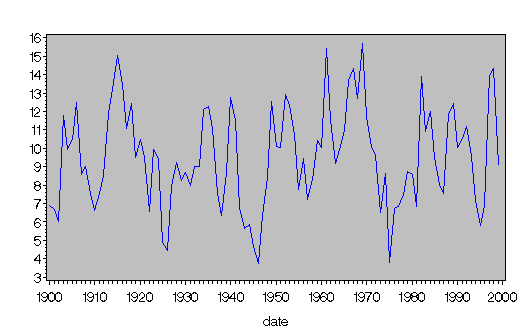| Time Series Analysis and Examples |
| Getting Started |
Consider a time series of length 100 from the ARMA(2,1) model
 |
where the error series follows a normal with mean 10 and standard deviation 2.
The following statements generate the ARMA(2,1) model, compute 10 lags of its autocovariance functions, and calculate its log-likelihood function and residuals:
proc iml;
/* ARMA(2,1) model */
phi = {1 -0.5 0.04};
theta = {1 0.25};
mu = 10;
sigma = 2;
nobs = 100;
seed = 3456;
lag = 10;
yt = armasim(phi, theta, mu, sigma, nobs, seed);
print yt;
call armacov(autocov, cross, convol, phi, theta, lag);
autocov = autocov`;
cross = cross`;
convol = convol`;
lag = (0:lag-1)`;
print autocov cross convol;
call armalik(lnl, resid, std, yt, phi, theta);
print lnl resid std;

The ARMASIM function generates the data shown in Figure 13.1.
In Figure 13.2, the ARMACOV subroutine prints the autocovariance functions of the ARMA(2,1) model and the covariance functions of the moving-average term with lagged values of the process and the autocovariance functions of the moving-average term.
The first column in Figure 13.3 shows the log-likelihood function, the estimate of the innovation variance, and the log of the determinant of the variance matrix. The next two columns are part of the results in the standardized residuals and the scale factors used to standardize the residuals.
Copyright © SAS Institute, Inc. All Rights Reserved.